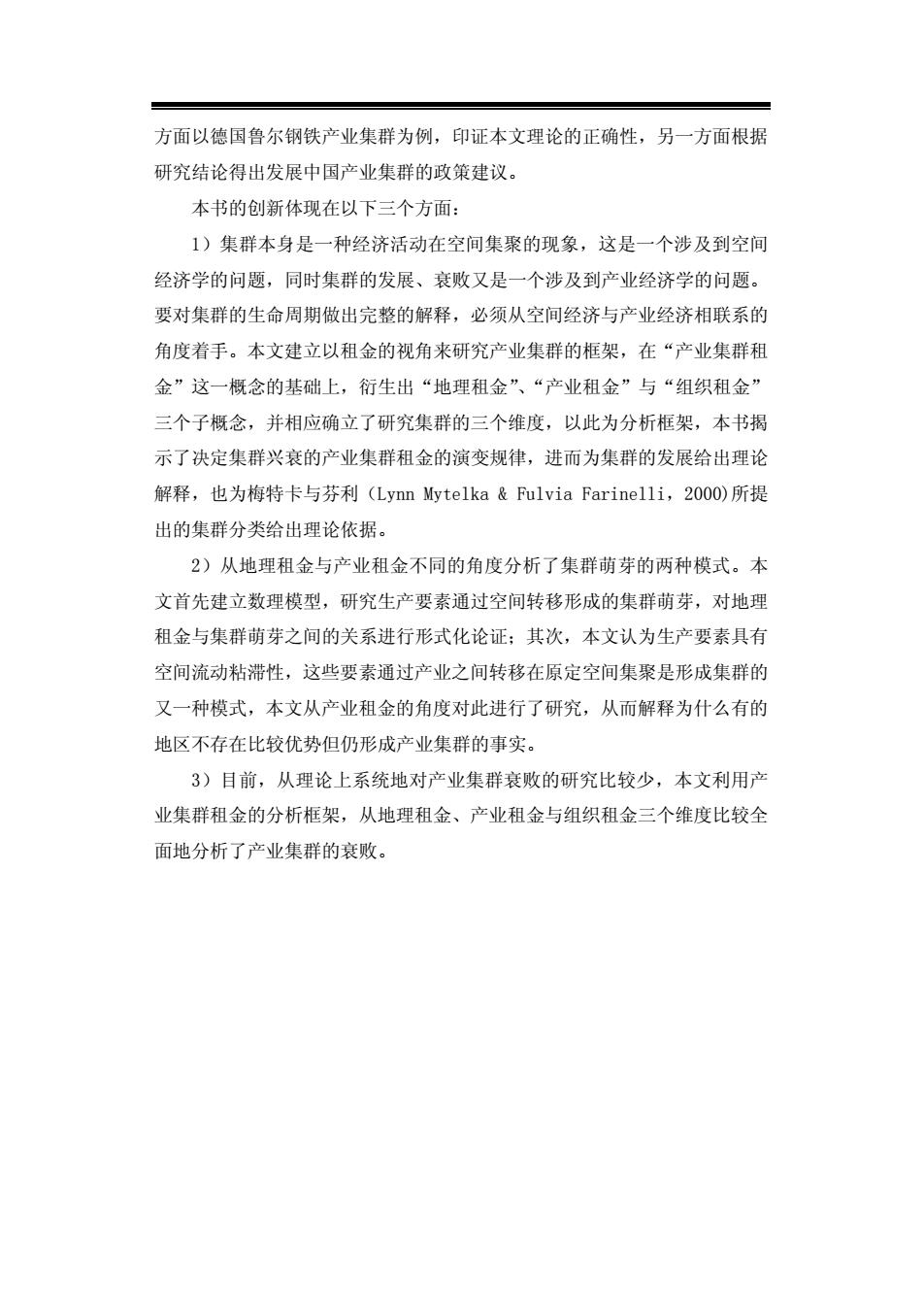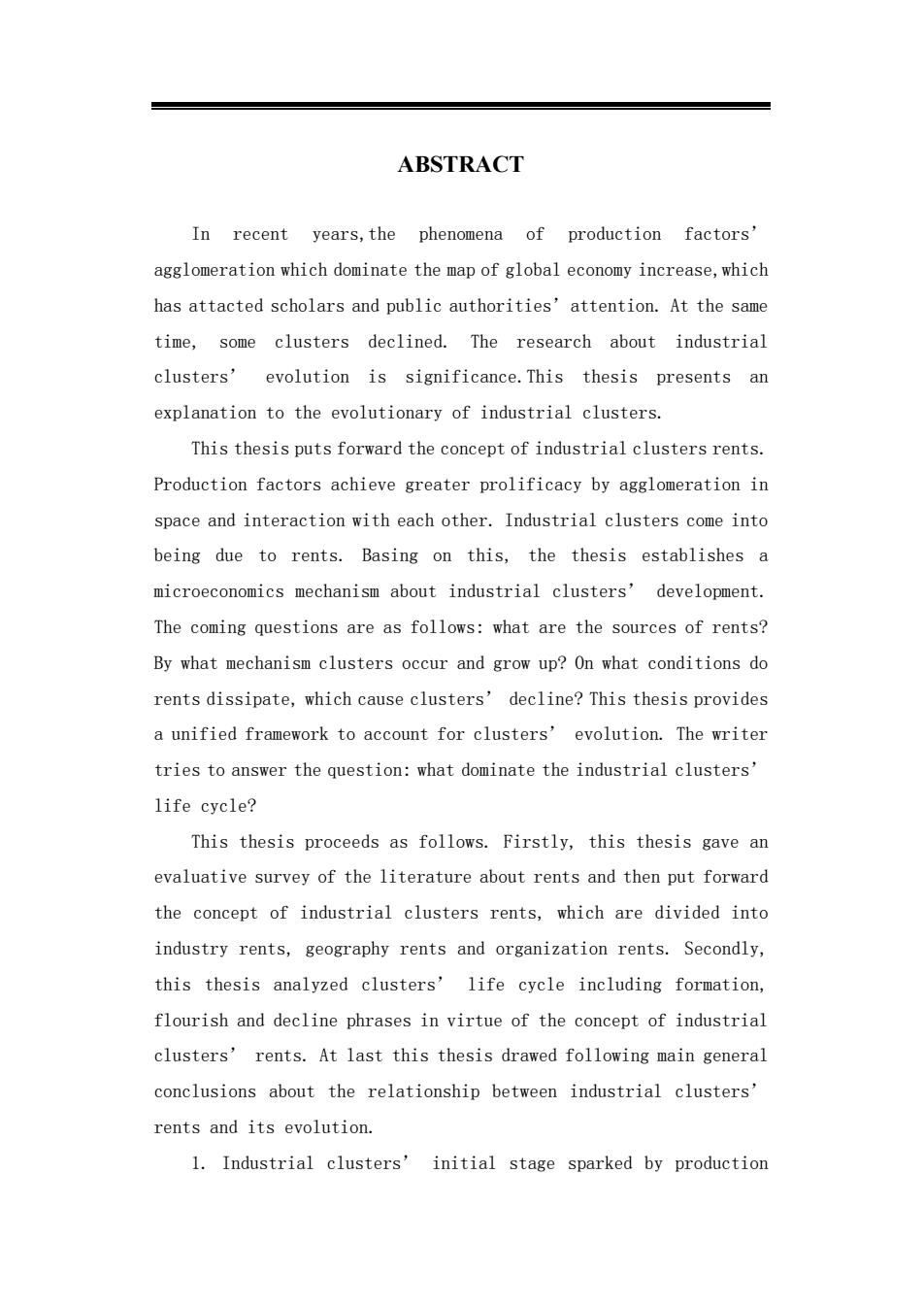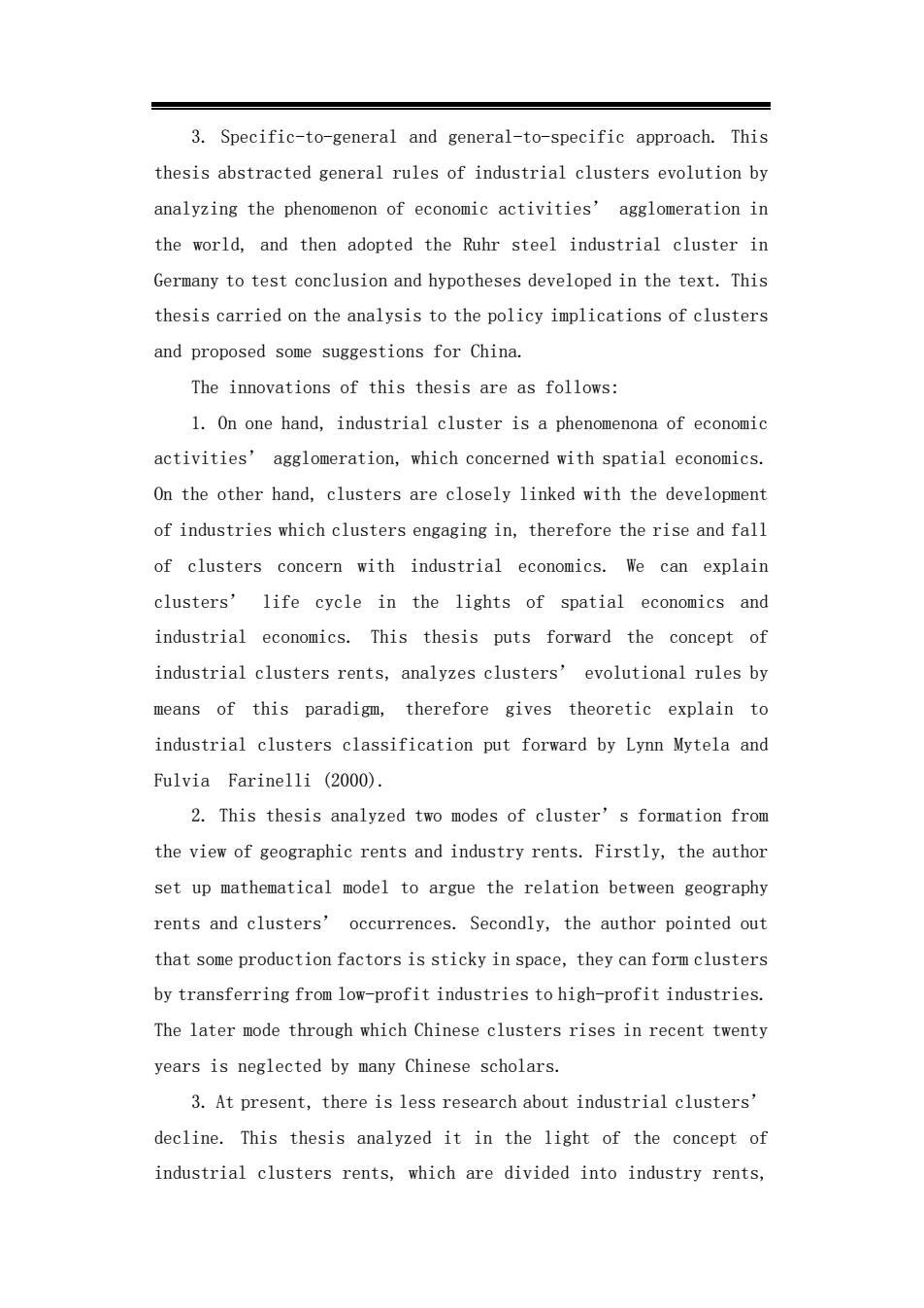
方面以德国鲁尔钢铁产业集群为例,印证本文理论的正确性,另一方面根据 研究结论得出发展中国产业集群的政策建议。 本书的创新体现在以下三个方面: 1)集群本身是一种经济活动在空间集聚的现象,这是一个涉及到空间 经济学的问题,同时集群的发展、衰败又是一个涉及到产业经济学的问题。 要对集群的生命周期做出完整的解释,必须从空间经济与产业经济相联系的 角度着手。本文建立以租金的视角来研究产业集群的框架,在“产业集群租 金”这一概念的基础上,衍生出“地理租金”、“产业租金”与“组织租金” 三个子概念,并相应确立了研究集群的三个维度,以此为分析框架,本书揭 示了决定集群兴衰的产业集群租金的演变规律,进而为集群的发展给出理论 解释,也为梅特卡与芬利(Lynn Mytelka&Fulvia Farinelli,200o)所提 出的集群分类给出理论依据。 2)从地理租金与产业租金不同的角度分析了集群萌芽的两种模式。本 文首先建立数理模型,研究生产要素通过空间转移形成的集群萌芽,对地理 租金与集群萌芽之间的关系进行形式化论证:其次,本文认为生产要素具有 空间流动粘滞性,这些要素通过产业之间转移在原定空间集聚是形成集群的 又一种模式,本文从产业租金的角度对此进行了研究,从而解释为什么有的 地区不存在比较优势但仍形成产业集群的事实。 3)目前,从理论上系统地对产业集群衰败的研究比较少,本文利用产 业集群租金的分析框架,从地理租金、产业租金与组织租金三个维度比较全 面地分析了产业集群的衰败
方面以德国鲁尔钢铁产业集群为例,印证本文理论的正确性,另一方面根据 研究结论得出发展中国产业集群的政策建议。 本书的创新体现在以下三个方面: 1)集群本身是一种经济活动在空间集聚的现象,这是一个涉及到空间 经济学的问题,同时集群的发展、衰败又是一个涉及到产业经济学的问题。 要对集群的生命周期做出完整的解释,必须从空间经济与产业经济相联系的 角度着手。本文建立以租金的视角来研究产业集群的框架,在“产业集群租 金”这一概念的基础上,衍生出“地理租金”、“产业租金”与“组织租金” 三个子概念,并相应确立了研究集群的三个维度,以此为分析框架,本书揭 示了决定集群兴衰的产业集群租金的演变规律,进而为集群的发展给出理论 解释,也为梅特卡与芬利(Lynn Mytelka & Fulvia Farinelli,2000)所提 出的集群分类给出理论依据。 2)从地理租金与产业租金不同的角度分析了集群萌芽的两种模式。本 文首先建立数理模型,研究生产要素通过空间转移形成的集群萌芽,对地理 租金与集群萌芽之间的关系进行形式化论证;其次,本文认为生产要素具有 空间流动粘滞性,这些要素通过产业之间转移在原定空间集聚是形成集群的 又一种模式,本文从产业租金的角度对此进行了研究,从而解释为什么有的 地区不存在比较优势但仍形成产业集群的事实。 3)目前,从理论上系统地对产业集群衰败的研究比较少,本文利用产 业集群租金的分析框架,从地理租金、产业租金与组织租金三个维度比较全 面地分析了产业集群的衰败

ABSTRACT In recent years,the phenomena of production factors' agglomeration which dominate the map of global economy increase,which has attacted scholars and public authorities'attention.At the same time,some clusters declined.The research about industrial clusters'evolution is significance.This thesis presents an explanation to the evolutionary of industrial clusters. This thesis puts forward the concept of industrial clusters rents. Production factors achieve greater prolificacy by agglomeration in space and interaction with each other.Industrial clusters come into being due to rents.Basing on this,the thesis establishes a microeconomics mechanism about industrial clusters'development. The coming questions are as follows:what are the sources of rents? By what mechanism clusters occur and grow up?On what conditions do rents dissipate,which cause clusters'decline?This thesis provides a unified framework to account for clusters'evolution.The writer tries to answer the question:what dominate the industrial clusters' life cycle? This thesis proceeds as follows.Firstly,this thesis gave an evaluative survey of the literature about rents and then put forward the concept of industrial clusters rents,which are divided into industry rents,geography rents and organization rents.Secondly, this thesis analyzed clusters'life cycle including formation, flourish and decline phrases in virtue of the concept of industrial clusters'rents.At last this thesis drawed following main general conclusions about the relationship between industrial clusters' rents and its evolution. 1.Industrial clusters'initial stage sparked by production
ABSTRACT In recent years,the phenomena of production factors’ agglomeration which dominate the map of global economy increase,which has attacted scholars and public authorities’attention. At the same time, some clusters declined. The research about industrial clusters’ evolution is significance.This thesis presents an explanation to the evolutionary of industrial clusters. This thesis puts forward the concept of industrial clusters rents. Production factors achieve greater prolificacy by agglomeration in space and interaction with each other. Industrial clusters come into being due to rents. Basing on this, the thesis establishes a microeconomics mechanism about industrial clusters’ development. The coming questions are as follows: what are the sources of rents? By what mechanism clusters occur and grow up? On what conditions do rents dissipate, which cause clusters’ decline? This thesis provides a unified framework to account for clusters’ evolution. The writer tries to answer the question: what dominate the industrial clusters’ life cycle? This thesis proceeds as follows. Firstly, this thesis gave an evaluative survey of the literature about rents and then put forward the concept of industrial clusters rents, which are divided into industry rents, geography rents and organization rents. Secondly, this thesis analyzed clusters’ life cycle including formation, flourish and decline phrases in virtue of the concept of industrial clusters’ rents. At last this thesis drawed following main general conclusions about the relationship between industrial clusters’ rents and its evolution. 1. Industrial clusters’ initial stage sparked by production

factors'chasing for industrial clusters rents.Firms achieve greater prolificacy by agglomeration in space,cooperation with each other and proximity of social relationship.Therefore enterprises in clusters can yield much more rents.Geography rents yield by resource advantage,favorable culture and historical circumstances, traditional craft,information and knowledge diffusion,plausible policies by government in local region,so industrial clusters come into being due to geography rents.Besides this,clusters may form when some sticky production factors in space transfer from low-profit industries to high-profit industries.Obviously,the formation of clusters will be spurred if production factors both inside and outside the region concentrate in one area.Therefore,we can promote industrial clusters'development by eliminating market entrance barrier,carrying out trade liberation policy and avoiding government irrelevant intervention. 2.As the main sources of industrial clusters rents turn to the organization rents from the industry rents and geography rents,the industrial clusters evolve from the informal industrial clusters to the organized industrial clusters,the later ones are more complicated and advanced.In the informal clusters,enterprises agglomerate in space to gain external economies passively.In the formal clusters, enterprises cooperate and harmonize with each others,therefore overcome many disadvantages that independent small enterprises cann't get over.The government and industrial institute play important rule in this stage. 3.When industries experience downthrown demand in the market, clusters decline spontaneously.Industrial clusters will lose exogenous comparative advantages due to dissipation of geography rents.If clusters can't yield organization rents endogenous to resist centrifugal forces,the industrial cluster will decline
factors’ chasing for industrial clusters rents. Firms achieve greater prolificacy by agglomeration in space, cooperation with each other and proximity of social relationship. Therefore enterprises in clusters can yield much more rents. Geography rents yield by resource advantage, favorable culture and historical circumstances, traditional craft, information and knowledge diffusion, plausible policies by government in local region, so industrial clusters come into being due to geography rents. Besides this, clusters may form when some sticky production factors in space transfer from low-profit industries to high-profit industries. Obviously, the formation of clusters will be spurred if production factors both inside and outside the region concentrate in one area. Therefore, we can promote industrial clusters’ development by eliminating market entrance barrier, carrying out trade liberation policy and avoiding government irrelevant intervention. 2. As the main sources of industrial clusters rents turn to the organization rents from the industry rents and geography rents, the industrial clusters evolve from the informal industrial clusters to the organized industrial clusters, the later ones are more complicated and advanced. In the informal clusters, enterprises agglomerate in space to gain external economies passively. In the formal clusters, enterprises cooperate and harmonize with each others, therefore overcome many disadvantages that independent small enterprises cann’t get over. The government and industrial institute play important rule in this stage. 3. When industries experience downthrown demand in the market, clusters decline spontaneously. Industrial clusters will lose exogenous comparative advantages due to dissipation of geography rents. If clusters can’t yield organization rents endogenous to resist centrifugal forces, the industrial cluster will decline

Furthermore,clusters face the fate of decay when there are no enough innovations. 4.Innovation,especially revolutionary innovation,may change clusters'developing route.Sustainable industrial clusters rents are yielded by innovation.The essence of innovation is yield rents when enterprises in clusters grasp profit-gained chances when economy is in the process of adjustment.When the extent of disequilibrium in economy reduces,innovation rents dissipate gradually.Marginal returns diminish until next innovation come into being.When economy swings between equilibrium and disequilibrium it is innovation by which production factors yield increasing returns by mechanism of positive feedback.So innovation rents are sustainable source of industrial clusters rents,and innovation is everlasting impetus for clusters. The main research methods adopted in this thesis are as follows: 1.Unification of history and logic approach.The aim of production factors is maximizing their profit.Their choices of location and industries lead to the origin of clusters,and this is the logic start-up of this research.This thesis holds that the industrial clusters come into being due to the industrial clusters rents.The change of industrial clusters rents'main source is closely linked with clusters'development. 2.Dialectic approach.Being one kind of economic organization, cluster can improve economic efficiency.But everything is paradoxical.Chinese traditional philosophy and western dialectician both emphasize the law of contradiction.Under certain conditions too strong cooperation relationship in clusters may damage the economic efficiency of inter-firm network,even lead clusters to "problem areas".To appraise industrial clusters objectively,this thesis analyzes systematically the damage of clusters to regional economy
Furthermore, clusters face the fate of decay when there are no enough innovations. 4. Innovation, especially revolutionary innovation, may change clusters’ developing route. Sustainable industrial clusters rents are yielded by innovation. The essence of innovation is yield rents when enterprises in clusters grasp profit-gained chances when economy is in the process of adjustment. When the extent of disequilibrium in economy reduces, innovation rents dissipate gradually. Marginal returns diminish until next innovation come into being. When economy swings between equilibrium and disequilibrium it is innovation by which production factors yield increasing returns by mechanism of positive feedback. So innovation rents are sustainable source of industrial clusters rents, and innovation is everlasting impetus for clusters. The main research methods adopted in this thesis are as follows: 1. Unification of history and logic approach. The aim of production factors is maximizing their profit. Their choices of location and industries lead to the origin of clusters, and this is the logic start-up of this research. This thesis holds that the industrial clusters come into being due to the industrial clusters rents. The change of industrial clusters rents’ main source is closely linked with clusters’ development. 2. Dialectic approach. Being one kind of economic organization, cluster can improve economic efficiency. But everything is paradoxical. Chinese traditional philosophy and western dialectician both emphasize the law of contradiction. Under certain conditions too strong cooperation relationship in clusters may damage the economic efficiency of inter-firm network, even lead clusters to “problem areas”. To appraise industrial clusters objectively, this thesis analyzes systematically the damage of clusters to regional economy

3.Specific-to-general and general-to-specific approach.This thesis abstracted general rules of industrial clusters evolution by analyzing the phenomenon of economic activities'agglomeration in the world,and then adopted the Ruhr steel industrial cluster in Germany to test conclusion and hypotheses developed in the text.This thesis carried on the analysis to the policy implications of clusters and proposed some suggestions for China. The innovations of this thesis are as follows: 1.On one hand,industrial cluster is a phenomenona of economic activities'agglomeration,which concerned with spatial economics. On the other hand,clusters are closely linked with the development of industries which clusters engaging in,therefore the rise and fall of clusters concern with industrial economics.We can explain clusters'life cycle in the lights of spatial economics and industrial economics.This thesis puts forward the concept of industrial clusters rents,analyzes clusters'evolutional rules by means of this paradigm,therefore gives theoretic explain to industrial clusters classification put forward by Lynn Mytela and Fulvia Farinelli (2000). 2.This thesis analyzed two modes of cluster's formation from the view of geographic rents and industry rents.Firstly,the author set up mathematical model to argue the relation between geography rents and clusters'occurrences.Secondly,the author pointed out that some production factors is sticky in space,they can form clusters by transferring from low-profit industries to high-profit industries. The later mode through which Chinese clusters rises in recent twenty years is neglected by many Chinese scholars. 3.At present,there is less research about industrial clusters' decline.This thesis analyzed it in the light of the concept of industrial clusters rents,which are divided into industry rents
3. Specific-to-general and general-to-specific approach. This thesis abstracted general rules of industrial clusters evolution by analyzing the phenomenon of economic activities’ agglomeration in the world, and then adopted the Ruhr steel industrial cluster in Germany to test conclusion and hypotheses developed in the text. This thesis carried on the analysis to the policy implications of clusters and proposed some suggestions for China. The innovations of this thesis are as follows: 1. On one hand, industrial cluster is a phenomenona of economic activities’ agglomeration, which concerned with spatial economics. On the other hand, clusters are closely linked with the development of industries which clusters engaging in, therefore the rise and fall of clusters concern with industrial economics. We can explain clusters’ life cycle in the lights of spatial economics and industrial economics. This thesis puts forward the concept of industrial clusters rents, analyzes clusters’ evolutional rules by means of this paradigm, therefore gives theoretic explain to industrial clusters classification put forward by Lynn Mytela and Fulvia Farinelli (2000). 2. This thesis analyzed two modes of cluster’s formation from the view of geographic rents and industry rents. Firstly, the author set up mathematical model to argue the relation between geography rents and clusters’ occurrences. Secondly, the author pointed out that some production factors is sticky in space, they can form clusters by transferring from low-profit industries to high-profit industries. The later mode through which Chinese clusters rises in recent twenty years is neglected by many Chinese scholars. 3. At present, there is less research about industrial clusters’ decline. This thesis analyzed it in the light of the concept of industrial clusters rents, which are divided into industry rents